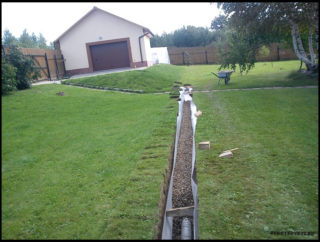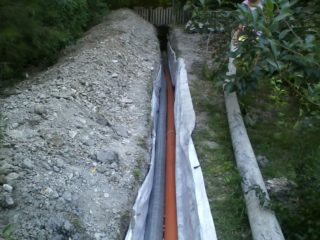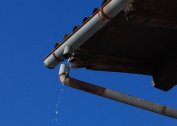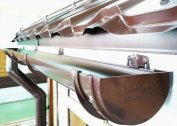When building a house on a site with a high level of groundwater, drainages are laid that protect the building from spring flooding, soil erosion, destruction of the gutter and basement flooding. To minimize the costs of equipping the drainage system, drainage and storm sewage are laid in one trench.
Purpose of drainage and storm sewage
The stormwater collects melt and rainwater into gutters and rain gutters, then diverts water to the wells through a pipeline. It combines the outdoor drainage system and underground wiring.
To drain the wetlands, drainage is used, which does not allow the groundwater level to rise, diverting them with the help of perforated pipes along the length of the pipes to the drainage wells. Given the general orientation of the problem - the removal of excess water - combine drainage schemes in order to subsequently wisely use natural resources, directing industrial water, for example, to irrigate a garden or flower garden.
Sharing a trench does not mean pooling schemes. Drainage and stormwater in one pipe will overload the perforated drains in peak mode, which will not allow to remove groundwater in time and cause flooding of the site.
Drain wiring can only be closed, as it is laid underground. Several conditions that determine the need for its installation:
- the aquifer lies close to the surface;
- according to the characteristics of the soil is clay or loam;
- the site is located in the area of frequent floods;
- the foundation mark is below ground level;
- construction is planned in the lowland.
Elements of the drainage system:
- pipes made of geotextile with perforation (drains) used to collect "excess" fluid;
- sand traps;
- a pipeline of plastic, asbestos-cement or ceramic pipes to divert the collected water;
- viewing wells.
Pipes of both systems can be placed in one trench, which will facilitate installation and reduce costs.
Combination of storm and drainage
The task that is set before the builders is to discharge the sewage according to autonomous schemes into one drainage well. For this, a nodal tee is used, which combines the external streams of rainwater with the drainage of groundwater.
Drains buried in the area collect the raised groundwater and drain pipes into a well from which they are pumped and discharged to a designated place.
Typically, storm drains are collected in a collector, which is located in the same trench with a drainage pipeline, water flows from the collector into the main network, then to the bypass well, from where it is also pumped out.
You can connect the stormwater drainage with drainage using a nodal tee to output the flow into one highway in the direction of a common drainage well. Pipes are laid under the slope established by SNiP for sections of different sizes. For example, for Dm110 mm, the slope is 2 cm per linear meter.
Dual System Installation Rules
Before installation, design work is carried out with a topographic survey of the area. The capacity for pipelines is calculated, which should ensure the drainage of water in overload mode.
When you bookmark, you must follow these recommendations:
- The arrangement of drains requires significant investment. Erroneous calculations will lead to additional costs. Restoring a broken system is quite difficult, it is easier to build a new one.
- Combining stormwater and drainage in one trench is permissible, but they are located at different depths. A well to collect water may be common.
- The depth of the ditch is carried out taking into account the layer of rubble and sand, which should provide better filtration of water.
- Perforated drains are laid below a storm pipeline.
- Pipes are placed at some distance from each other. This protects the drainage system from overload in the event of storm damage.
- The maximum laying depth of the collector with a diameter of 700 mm is 120 cm.
The efficient operation of the combined circuit will preserve the integrity of the foundation and prevent flooding. Funds that would be spent on the arrangement of both drainage systems and waterproofing will be halved.
Operation and maintenance
Without preventive cleaning, stormwater and drainage are silted, clogged with sand and clay. Inspections are carried out in the dry autumn period or at the beginning of winter. The main task: to verify the integrity of the drainage system and maintain its throughput.
Piping is cleaned with a normal hose and clean water, which is supplied under high pressure. Dirt rushes into the well, from where it needs to be scooped up, then manually scrub the walls and bottom. Trays, gutters and ditches for collecting rainwater are also washed, cleaning from dirt.
The regularity of the cleaning will guarantee stable operation of the storm sewer and drainage system.





